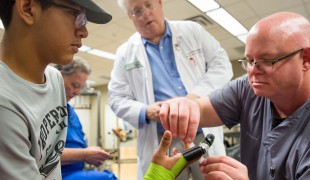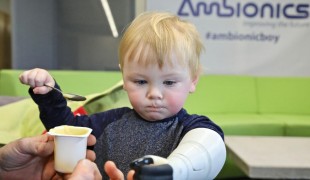- 9622
- 647
- 16
- 12
- 0
- Help Ukraine
About the solution
Jordan had the help of her prosthetist, David Rotter, and from Sam Hobish, a designer from Autodesk. Together they combined a medical-grade prosthetic arm with 3D printed attachments at the wrist.
The girl has been working with David since she was three, and together they had the idea of creating a traditional prosthetic arm with a connection at the wrist for screwing in a 3D printed hand. The printed hand then connects with string to a shoulder harness, the kind that Jordan already uses to control her standard prosthetic hook. By moving her shoulder, Jordan can control the hand's grasp.
This means that Jordan doesn't need to always have a hand in her prosthesis. It can be a hook or anything that they decide to 3D print and attach to the 3D printing arm. Jordan just needs to glue the attachment onto a compatible screw if she wants to connect future different creations, which she says she can buy at any hardware store.
To move and control the 3D printed hand, the user can simply move their shoulder to trigger a string that connects the 3D printed extension to a shoulder harness.
According to the inventors, this may be the first hybrid prosthetic arm made of medical and printed parts, so in a sense Jordan has made her way to the cutting edge of the worlds of medical and 3D printed prosthetics.
Jordan started by using the designs provided by Enable and then Autodesk and Dremel gave her a 3D printer to use at home, and Awesome Without Borders chipped in $1,000 for filament.
"She came with the challenge because she and Sam were trying to figure out a way to use those standard 3D-printed hands, and it got pretty aggravating. She realized that it was not possible with any of the current 3D printed design concepts, since she doesn't have an elbow", explained Jen Reeves, Jordan's mother.
Jordan is now thinking of developing a portable tool that could help people with disabilities use paper-towel dispensers more easily.
The inventor's mother founded a nonprofit called Born Just Right, which aims to help disabled kids and their parents to learn about design and connect them with organizations that want to get involved in this process.
More info: https://www.bornjustright.org
Adapted from: http://bit.ly/2Bfx8Oq
This solution shall not include mention to the use of drugs, chemicals or biologicals (including food); invasive devices; offensive, commercial or inherently dangerous content. This solution was not medically validated. Proceed with caution! If you have any doubts, please consult with a health professional.
DISCLAIMER: This story was written by someone who is not the author of the solution, therefore please be advised that, although it was written with the utmost respect for the innovation and the innovator, there can be some incorrect statements. If you find any errors please contact the patient Innovation team via info@patient-innovation.com
-
-
426
-
1
-
10294

Man 3D prints finger for boy to help him play baseball better
-
-
-
467
-
0
-
5764

Father creates a bionic limb for his baby son using Xbox scanner and 3D printer
-
-
-
359
-
0
-
4190

Father 3D prints racing gloves for his daughter
Grip
MOVING IN A WHEELCHAIR: Moving using a wheelchair.
Neuromuscular Disorders
Muscular Dystrophy
Paralysis
Spinal Cord and Nerve Root Disorders
Cervical spinal cord injury/Tetraplegia
3d Printed
Body-Worn solutions (Clothing, accessories, shoes, sensors...)
Walking Aid (wheelchair/walker/crutches)
Muscle cramps or spasms
Difficulty coordinating movements
Stiffness or rigidity (difficulty moving)
Paralysis of the legs and lower body
Muscle weakness
Restoring mobility
Maintaining Balance and Mobility
Preventing (Vaccination, Protection, Falls, Research/Mapping)
Medical Genetics
Neurology
Pediatrics
United States
-
 en
en